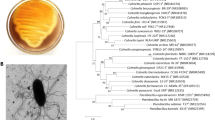Abstract
The gene for β-agarase of an Agarivorans sp. JA-1 was expressed in Bacillus subtilis strain DB104 for efficient and economical mass-production of the enzyme. We isolated 360 mg protein with a specific activity of 201 U/mg from the culture broth. The efficiency of production was approximately 130-fold higher than that in E. coli. The enzyme produced neoagarohexaose, neoagarotetraose and neoagarobiose from agar. Neoagarooligosaccharides produced by the enzyme had a whitening effect and inhibited tyrosinase activity in the murine melanoma cell line, B16F10. Neoagarooligosaccharides were not cytotoxic to B16F10 or normal cells. β-Agarase could therefore be a good whitening, cosmetic additive.





Similar content being viewed by others
References
Araki C (1959) Seaweed polysaccharides. In: Wolfrom ML (eds) Carbohydrate chemistry of substances of biological interest. Pergamon Press, London, pp 15–30
Briganti S, Camera E, Picardo M (2003) Chemical and instrumental approaches to treat hyperpigmentation. Pigment Cell Res 16:101–110
Duckworth M, Yaphe W (1970) Thin-layer chromatographic analysis of enzymic hydrolysate of agar. J Chromatogr 49:482–487
Groleau D, Yaphe W (1977) Enzymatic hydrolysis of agar: purification and characterization of β-neoagarotetraose hydrolase from Peudomonas atlantica. Can J Microbiol 23:672–679
Hearing VJ (2005) Biogenesis of pigment granules: a sensitive way to regulate melanocyte function. J Dermatol Sci 37:3–14
Kadekaro AL, Kanto H, Kavanagh R, Abdel-Malek ZA (2003) Significance of the melanocortin 1 receptor in regulating human melanocyte pigmentation, proliferation, and survival. Ann NY Acad Sci 994:359–365
Kang NY, Choi YR, Cho YS, Kim BK, Jeon BS, Cha JY, Kim CH, Lee YC (2003) Cloning, expression and characterization of a β-agarase gene from a marine bacterium, Pseudomonas sp. SK38. Biotechnol Lett 23:1165–1170
Kim BJ, Kim HJ, Ha SD, Hwang SH, Byun DS, Lee TH, Kong JY (1999) Purification and characterization of β-agarase from marine bacterium Bacillus cereus ASK202. Biotechnol Lett 21:1011–1105
Kobayashi R, Takisada M, Suzuki T, Kirimura K, Usami S (1997) Neoagarobiose as a novel moisturizer with whitening effect. Biosci Biotechnol Biochem 61:162–163
Kohno T, Kitagawa H, Hiraga T (1990) Production of hetero-oligosaccharides. In: Gijutsu Kenkyu Kukami (eds) Shokuhin sangyo bioreactor system, Jissen bioreactor. Shokuhin Kagaku Shimbunsa, Tokyo, Japan, pp 87–105
Kong JY, Hwang SH, Kim BJ, Bae SK, Kim JD (1997) Cloning and expression of an agarase gene from a marine bacterium Pseudomonas sp. w7. Biotechnol Lett 19:23–26
Kono T, Hidaka H (1989) Properties and production of neoagarooligosaccharide. Nippon Nogeikagaku Kaishi 63:1126–1129
Lee DG, Park GT, Kim NY, Lee EJ, Jang MK, Shin YG, Park GS, Kim TM, Lee JH, Lee JH, Kim SJ, Lee SH (2006) Cloning, expression, and characterization of a glycoside hydrolase family 50 beta-agarase from a marine Agarivorans isolate. Biotechnol Lett 28:1925–1932
Mayer AM (1987) Polyphenol oxidases in plants. Recent progress. Phytochemistry 26:11–20
O’Donoghue JL (2006) Hydroquinone and its analogues in dermatology – a risk-benefit viewpoint. J Cosmet Dermatol 5:196–203
Ohta Y, Nogi Y, Miyazaki M, Li Z, Hatada Y, Ito S, Horikoshi K (2004) Enzymatic properties and nucleotide and amino acid sequences of a thermostable beta-agarase from the novel marine isolate, JAMB-A94. Biosci Biotechnol Biochem 68:1073–1081
Passi S, Nazzaro-Porro M (1981) Molecular basis of substrate and inhibitory specificity of tyrosinase: phenolic compounds. Br J Dermatol 104:659–665
Pifferi PG, Baldassari L, Cultrera R (1974) Inhibition by carboxylic acids of an o-diphenol oxidase from Prunus avium fruits. J Sci Food Agric 25:263–270
Sambrook E, Fritsch F, Maniatis T (1989) Molecular cloning: a laboratory manual, 2nd edn. Cold Spring Harbor Labarotory, Cold Spring Harbor, New York
Seo SY, Sharma VK, Sharma N (2003) Mushroom tyrosinase: recent prospects. J Agric Food Chem 51:2837–2853
Seiberg M, Paine C, Sharlow E, Andrade-Gordon P, Costanzo M, Eisinger M, Shapiro SS (2000) Inhibition of melanosome transfer results in skin lightening. J Invest Dermatol 115:162–167
Somogyi M (1952) Notes on sugar determination. J Biol Chem 195:19–23
Sturm RA, Teasdale RD, Box NF (2001) Human pigmentation genes: identification, structure and consequences of polymorphic variation. Gene 277:49–62
Yabuta T (1924) The constitution of kojic acid, a gamma-pyrone derivative formed by Aspergillus oryzae from carbohydrates. J Chem Soc 125:575–587
Yoshizawa Y, Ametani A, Tsunehiro J, Nomura K, Itoh M, Fukui F, Kaminogawa S (1995) Macrophage stimulation activity of the polysaccharide fraction from a marine alga (Porphyra yezoensis): structure-function relationships and improved solubility. Biosci Biotechnol Biochem 59:1933–1937
Acknowledgement
This work was supported by the Marine and Extreme Genome Research Center Program, Ministry of Maritime Affairs & Fisheries, Republic of Korea.
Author information
Authors and Affiliations
Corresponding author
Rights and permissions
About this article
Cite this article
Lee, DG., Jang, M.K., Lee, OH. et al. Over-production of a glycoside hydrolase family 50 β-agarase from Agarivorans sp. JA-1 in Bacillus subtilis and the whitening effect of its product. Biotechnol Lett 30, 911–918 (2008). https://doi.org/10.1007/s10529-008-9634-4
Received:
Revised:
Accepted:
Published:
Issue Date:
DOI: https://doi.org/10.1007/s10529-008-9634-4



